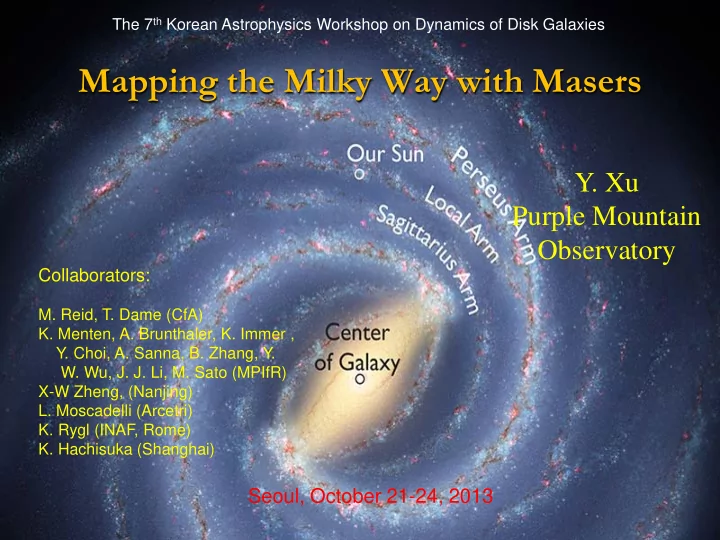

The 7 th Korean Astrophysics Workshop on Dynamics of Disk Galaxies Mapping the Milky Way with Masers Y. Xu Purple Mountain Observatory Collaborators: M. Reid, T. Dame (CfA) K. Menten, A. Brunthaler, K. Immer , Y. Choi, A. Sanna, B. Zhang, Y. W. Wu, J. J. Li, M. Sato (MPIfR) X-W Zheng, (Nanjing) L. Moscadelli (Arcetri) K. Rygl (INAF, Rome) K. Hachisuka (Shanghai) Seoul, October 21-24, 2013
Outline Puzzle about the spiral structure of the Milky Way Results of VLBI observations Future aspect and Conclusions
What does the Milky Way look like? Seen face-on Milky Way Star forming regions Inside the Milky Way, edge-on,
The First Evidence for Spiral Structure of MW Morgan et al. 1952, 1953
The “Standard” Model Orion spur Perseus ⊗ G75.8+0.4 ~ 5.7 kpc Perseus 3.2 kpc Local Norma Scutum-Crux Young stars, HI & HII Geogelin & Georgelin 1976
Double-arm structure ----Sagittarius & Perseus/Local Arm Perseus Bifurcation point ~ 60 ° Local Sagittarius Dust Urasin 1987
No Arm ! Open clusters (age < 2 × 10^7 yr) No arm ! Janes & Adler 1982
Puzzle for spiral structure Number of arms --- 2 3 4 5 ? Type of MW --- SBb or SBc ? Position, length and angle of the bar ? Parameters of MW ? Rotation curve? Reason: large uncertainty on distances
Large-scale structures H I CO Giants
Large distance uncertainty Difficulties in determining an accurate rotation curve Non-Circular Rotation Kinematic Distance Ambiguity G9.62+0.20: far kinematic dist. 15 kpc near 0.5 kpc Parallax Distance 5.7 kpc Kinematically anomalous W3OH: Kinematic Distance ~ 4.3 kpc Parallax Distance ~ 2.0 kpc
Very Long Baseline Interferometry VLBA VERA EVN • Radio waves “ see ” through galaxy • Can “ synthesize ” telescope the size of the Earth
The BeSSeL Survey & VERA VLBI Exploration of Radio Astrometry • ~ 1000 masers • will yield accurate distances to most HMSFR, locate the spiral arms and the bar, measure R 0 and Θ 0 to ~1%, and measure the rotation curve.
Parallax results: W3OH ( Masers ) Π = 0.512 ± 0.010 mas Xu, Reid, Zheng & Menten (2006) 2.0% D = 1.95 ± 0.04 kpc
Orion Nebula (Masers & Radio Stars) Literature: 350 – 500 pc (usually 480 ± 80 pc by Genzel et al. 1981) D = 389 ± 21 pc (Sandstrom et al. 2007) D = 437 ± 19 pc (Hirota et al. 2007) D = 414 ± 7 pc (Menten et al. 2007) 1.7% D = 419 ± 6 pc (Kim et al. 2008)
Cygnus X Star forming complex (Masers) Rygl et al. (2012 ) Image: van Langevelde
Galactic Center (H 2 O masers) Π = 129 ± 12 µ as (D=7.8 ± 0.8 kpc) Sgr B2 + = 0.8 7.9 kpc R 0.13 kpc − 0 0.7 Reid et al. 2009
W 49N (H 2 O masers) Π = 90 ± 6 µ as (D=11.1 ± 0.8 kpc) Smallest parallax ! Zhang et al. 2013
All parallax results • Preliminary results of parallaxes from VLBA, VERA & EVN: • ~ 100 sources • Tracing most spiral arms • Inner, bar-region is complicated Background: artist conception by Robert Hurt (NASA: SSC)
The new result in the 222 nd AAS meeting Old: local spur New: Local Arm (branch) Xu et al. (2013) Credit: Robert Hurt, IPAC; Bill Saxton, NRAO/IAUI/NSF
Counter-Rotation of Star Forming Regions Compute Galacto-centric V: Transform to frame rotating at Θ o = 245 km/s ( yellow ) See peculiar (non-circular) motions …clear counter-rotation Transform to frame rotating at Θ o = 220 km/s (red) Still counter-rotating
Change on Solar motion Until 2009, the Dehnen & Binney (1998) HIPPARCOS Solar motion of U 0 =10.00 ± 0.36 km/s (radially inwards), V 0 = 5.25 ± 0.62 km/s (in the direction of Galactic rotation), W 0 = 7.17 ± 0.38 km/s (vertically upwards) was widely accepted. After part of parallax results published, HIPPARCOS revised: Schoenrich, Binney & Dehnen (2010) U 0 = 11.1 ± 2.0 k/ms, V 0 = 12.2 ± 2.1 km/s, W 0 = 7.2 ± 2.0 km/s
Milky Way’s Rotation Curve • Parallax data • Schoenrich+2010 Solar Motion • Corrected for maser counter-rotation • Best fit: R 0 = 8.35 kpc, θ 0 = 248 km/s New and direct result based on 3-D motions “ gold standard ” distances , but close to the SUN.
Poor s ensitivity & field of view Sensitivity (VLBA): Masers: coherence time (flux density threshold) 5 Jy for 22 GHz H 2 O & 12.2 GHz CH 3 OH ~300/3000 2 Jy for 6.7 GHz CH 3 OH 400/2000 Most of sources available on our side of MW Astrometric accuracy : ionospheric & tropospheric effects close calibrators (in-beam style) Systematic errors scale with the separation between targets and calibrators: W3OH: 0.5+/-0.010 mas (separation ~ 0.8 ° ), 0.5+/-0.017 mas (separation ~ 1.5 ° ) Lack of stations in the southern sky
Future VLBI Astrometry ---- SKA large field of view & sensitivity - Target sources Masers: 1000 → 5000; - Calibrators QSOs: 10 4 → 10 6 - Accuracy Several in-beam calibrators Systematic errors greatly reduced Parallaxes of ~ 1 µ as
Conclusions VLBA, VERA & EVN parallaxes to (massive) young stars (via masers) tracing spiral structure of Milky Way Star forming regions “ counter-rotate ” by ~8 km/s (for V sun =12 km/s) Parallax/proper motions: R o ~ 8.35 ± 0.2 kpc; Θ o ~ 248 ± 8 km/s/kpc SKA will construct the accurate the spiral structure of the Milky Way finally
Recommend
More recommend